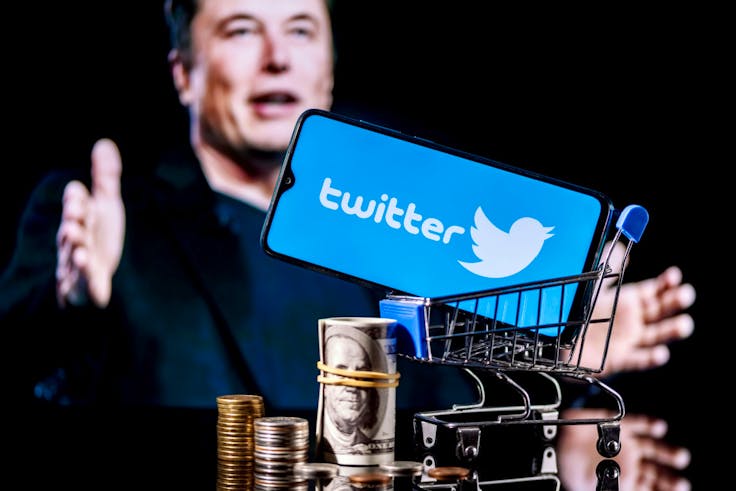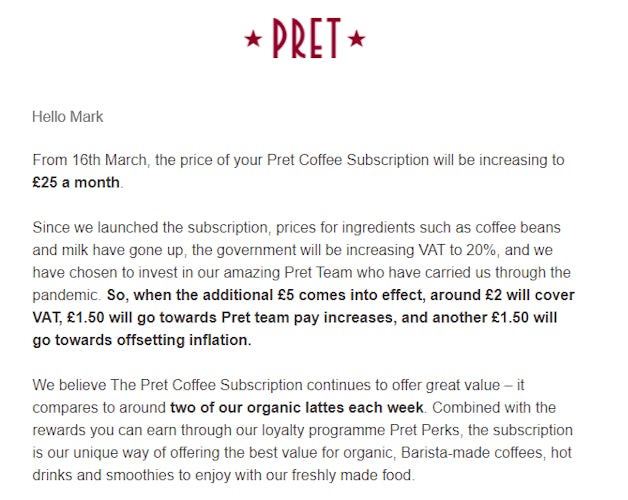Five lessons on how not to do pricing from Elon Musk’s Twitter
There is a perfect pricing case study in the way the new Twitter CEO, Elon Musk, communicated his proposed fee for a ‘blue tick’ on the platform – just do the exact opposite of what he did.

I have about 35 different feelings about Elon Musk. They range from positivity bordering on adoration (Starlink for Ukraine), through to neutral (The Boring Company), to disgust (animal experimentation for Neuralink).
And while that multiplicity of response often proves complex and contradictory, it does enable me to step back with dispassion as one-note windbags announce, via Twitter, that they intend to leave – probably leave, certainly consider leaving – the platform because of the new ‘Chief Twit’.
If you are going to leave Twitter, leave! Announcing you are thinking about it, on Twitter, makes you look ridiculous.
And leave for a proper reason. Leave because it has become shit and largely dominated by superficial posturing. Leave because ‘marketing Twitter’ has become the opposite of all it once was. An obtuse refraction of marketing reality in which people talk about people who talk about people who do marketing, usually with an image of a World War II fighter plane that was bombed in the wrong places because correlation is not causation, or something.
As for the worthy brands now lining up to withdraw their ad money from Twitter. Why? The company and its new owner haven’t done anything yet. Are you seriously telling me that you are comfortable sponsoring a global football tournament built from neo-slave labour, for a government that imprisons members of the LGBT community for the horrendous crime of making love to each other, but you are withdrawing from Twitter because of what the new owner “might” do in the future? On Twitter?
Elon Musk takes over Twitter amid a challenging market for digital advertising
Exiting Twitter because of Elon Musk makes no sense. He has zero ideological positions on anything. Taking a stand against him is like fighting the wind – pointless and likely to leave you looking foolish while he blows elsewhere. And his enigmatic, empty Muskiness is stamped all over the current chaos that surrounds the acquisition of Twitter.
Here is a guy famous for being anti-advertising, now encouraging companies to see the value of ads on Twitter. Here is a guy that railed against the over-valuation of Twitter, now paying that price and trying, with no hope of success, to find $44bn of value. A guy who claimed that the Twitter user base was one third fake, now striving to prove its authenticity against his original claims. The guy seen as the only person that could fix Twitter, now portrayed as the one that will kill it. The guy who believed Twitter was an essential tool for free speech, who now asks users to pay to use it.
Taking a stand against him is like fighting the wind – pointless and likely to leave you looking foolish while he blows elsewhere.
It’s all very confusing and no-one can accurately predict how this whole, fascinating whirlwind will eventually play out. But there is one area where more certainty is possible. Where we can accurately assess Musk, Twitter and the current maelstrom of activity surrounding both. That area is pricing.
If you want to see a masterclass in how not to do pricing, Twitter is your go-to case study. It’s such a hot, digital mess that good marketers can simply take a perfectly inverted approach to Twitter and probably plough the right course for their brands.
Remember the great Seinfeld episode ‘The Opposite’, where perennial loser George Costanza succeeds by doing the exact reverse of what he would normally do? Well, that’s my advice for marketers currently involved in pricing. Follow Twitter’s moves and do the exact opposite. Specifically, watch, learn and reverse all five of the following Twitter pricing mistakes.
1. Ignore research, go straight to tactics
The point about pricing is that it is one of the Ps. A tactical part of the marketing triptych that you approach once your research has been completed. Research is crucial, because it turns out running Van Westerndorp analyses, or conjoint, or simply getting a handle on who your consumer is and what they think of the value they get from your brand, really fucking helps when it comes to what price you want to set and how you want to set it.
Or you can just skip this step and jump straight in with around $20 a month for Twitter Blue and be done with it. Why $20? Why monthly? Why start with Twitter Blue? Why not?
2. Ignore strategy, go straight to tactics
Once you complete your research, you are meant to move to strategy. This takes a little more time. But it means when you get to the pricing decisions you already have a solid grasp of who your target is, what they will pay, the source of your value and pricing power, and the objectives you need to achieve.
Or do it the Elon way. Take over the company and, within the first week, target your blue-tick loyalists with a 400% price increase and ask your notable influencers to pony up $240 a year for a verification mark that used to be free.
Not only did this idea go down badly, it went down badly with the people at the top of Twitter’s pecking order. People who actually make the platform interesting for the rest of us nobodies. Something Stephen King eloquently noted in his now infamous tweet.
We need to pay the bills somehow! Twitter cannot rely entirely on advertisers. How about $8?
— Elon Musk (@elonmusk) November 1, 2022
3. Create uncertainty around the price change – wobble a bit
Musk’s response to King, above, also demonstrates a key error. Having floated the $20 monthly price, Musk then more than halved it after King and others pushed back.
Twitter’s $20 price was seemingly pulled out of thin air, then sent right back to where it came from the moment even the slightest pressure was applied by the market, only to return in significantly reduced form less than a day later – with all pricing authority and certainty now abandoned. Thus creating a crucial vulnerability that is only now beginning to play out… on Twitter.
The textbook approach to any price change is to call it a ‘price increase’, explain why you are doing it, and then remind the customer of the value you still offer even at this higher price point. And, throughout this process, it is imperative that there is not an ounce of indecisive blood in the pricing water. The price will go up. And it will go up on this date. And it will happen for these reasons. Thank you.
When Pret a Manger added five quid to its monthly endless coffee deal earlier this year, the message was delivered with élan but also authority, certainty and plenty of advanced notice. It might have not been a universally popular move, but it was a non-negotiable one. And Pret’s brand, price point and endless coffee offer were all the better for it.

4. Don’t worry about framing, just set a price
In all my travels around pricing, for clients big and small, I would impart one overriding realisation. Price is not the same as pricing. And there are three parts to pricing.
There is the phase in which a company does the research and decision-making to set the price. Then there is the resulting price. And finally, there is the communication of that price to the market.
It is clear to me – in my third decade of doing this – that while all three stages are important, the last stage is the most crucial. And it’s the reason why we need marketers around the table when prices are raised.
In Dan Ariely’s famous example of pricing at The Economist, the magazine offered its online subscription for $59, a print subscription for $125 and a combined offer of both web and print subscription for $125. Ariely tested these options and 84% of his subjects opted for the third combined offer. But when he removed the print subscription and left students with a binary choice between web or combined print/web subscription, only 32% went for the combined offer.
The difference? The three alternatives that framed the value of the different prices.
Frame a price in the right way, with the right context and reference points, and most target consumers will buy. Try selling an ‘online course’ for £1,500 quid. Now do it framed against a £100,000 proper MBA. And see the difference.
Here, again, Twitter is hopelessly out of its depth. The only reference point any Twitter Blue user had was a service that cost them $4.99 last month. Suddenly, it’s $8 a month. No rationale. No alternatives to make the new price more compelling. No attempt to frame the new price. You just pay more. A lot more.
5. Value is all about the company, not the customer.
Ultimately, the biggest insight into the pricing errors at Twitter comes in Musk’s half-arsed, half-apologetic explanation to Stephen King. Challenged on the price increase, the Chief Twit admits that the change will happen because Twitter needs to “pay the bill somehow”. In that one, short sentence, we see all that is wrong with Musk’s approach to both pricing and marketing at Twitter.
An ethnography of pricing: How and why marketers should put up prices
To understand and excel in pricing, you must stop looking at your costs or your competitors’ prices and master the concept of value. The word value is a very handy one because the V has two vertical prongs pointing in two very different directions. One points to the organisation and its need to generate a profit and a sufficient and healthy rate of return. But the other, equally important, prong points to the market, and the need to understand what and how they perceive the offer and what they ultimately make of it. Find the price that delivers to both demands and success can follow.
Pricing for Musk is currently about how he tries to rescue the phenomenally bad deal that he has made to buy Twitter for $44bn. But, in all the sudden efforts to recoup his losses, he misses the point; the other prong of value.
Prices must also make sense and prove attractive to target consumers. And so far, with only a week at the helm, all Elon Musk has done is made a mess of his pricing, undermined his reputation, underwhelmed investors, confused customers and demonstrated an abject inability to handle this most important of Ps. A Chief Twit indeed.







